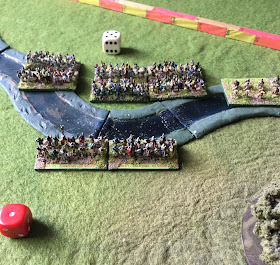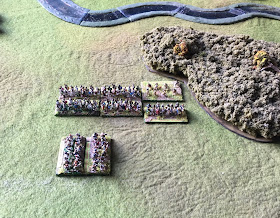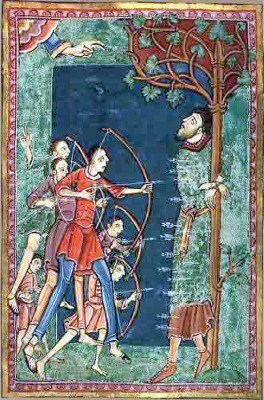Preparing for this game has taken a little longer than I expected. I had to add some stuff to the rules and I still don't have a set of spotting rules I am entirely convinced by. Then again the point of play testing is to settle on the rules that work and are fun to play.
New rules include acceleration and deceleration rates in level flight which vary from aeroplane to aeroplane very slightly and a set of workable kinetic energy rules (at least I think they are workable). I need to create some kind of height dials for my flight stands so for now the data on the flight charts will have to do. I have reworked the flight charts by adapting the chart from Richtofen's War. This was done as that system doesn't require a generic card for each and every aeroplane type. Which is a relief as I now have a start on the basic game data for almost 100 operational types that flew over the Western Front.
As previously mentioned the point of this game is to try out special manoeuvre rules to allow some basic fighter tactics to be used. The combatants are a pair of SE5As of the Royal Flying Corps on one side and for the Luftstreikrafte a selection chosen from an Albatros DVa a Fokker DVII and Halberstadt and Rumpler C class two seaters. The dogfight should involve more than the turning fight typical of 1916 and early 1917, or at least that is the plan. The toys are from Irregular Miniatures (the SE5As and Fokker DVII) and Heroics & Ros for the remaining German types. Transfers of German crosses and RFC roundels are I-94. The lozenge camouflage and ID letters and numbers I made myself.
 |
| The potential participants. Not much difference between the Irregular Minis and the H&R ones once painted |
In the above photo we have a Rumpler CV with the green and brown camouflage flanked by a Halberstadt CLII to the left and a Fokker DVII to the right. Behind that is an Albatros DVa (Orange and white) flanked by two SE5As.
The table is blank with no ground clutter to worry about and although I have plans for introducing rules about cloud cover, for this game it is clear blue skies.
My original plan was to have both sides enter from opposite sides of the table. That has changed as when the lockdown started I read an article in Miniature Wargames no 373 by Martin England on solo gaming using a threat generation system. This seems to be something that could work for solo air combat games as it builds in some fog of war, variable entry and direction and some vague spotting rules via the back door, as in if the enemy appear close by it's assumed you had failed to spot them. For game purposes I am playing a when they appear you have spotted them rule for my aeroplanes. Crude but workable for solo games. Martin's system was designed for land warfare but the basic ideas could be (and were) adapted.
The threat generation system
Before the game starts draw up a chart of ten potential encounters Using playing cards you could expand that but ten seems a nice round number the worked example assumes a pack of ten potential encounters hence using 10 cards for the initial pack, one per possible sighting. Remember that these could be triggered on consecutive turns so tailor the number of enemy aircraft produced on each sighting accordingly. My list for this game is:
- Two scouts
- Two scouts
- One scout
- Single two seater and two scouts
- Two two seaters
- Two two seaters
- One two seater and one scout
- One two seater and one scout
- One two seater
- One scout
Next take a pack of playing cards and select ten cards from one suit, Ace to 10 (if you use more or less encounters in your list increase/reduce the number of cards). Without seeing the face of the cards shuffle them and select two cards at random for each aircraft you are going to use on the player side and discard the rest.
Now from a different suit add the same number of cards as you have been left with for actual encounters (I suggest using red for live units and black for the extra cards representing dummy sightings). These extra cards will be dummy sightings where no enemy appears on the table.
Shuffle the cards and discard 1/3 at random still sight unseen (rounding down if necessary). Lastly add 2 cards from the dummy sighting suit for each aircraft you are using on the player side, shuffle again and place face down to the side of the playing area. This means most turns will generate a 'dummy' sighting.
If I have done my maths correctly for two player aircraft this should give me between one and three actual encounter cards At worst if they drop consecutively and the worst options come up I could face 6 scouts and a two seater almost simultaneously At best a single two seater all on it's lonesome. That seems like a reasonable mix and the worst case is pretty unlikely to happen
At the start of each enemy turn, turn over the top card and if it is a sighting check the encounter table. Discard that drawn card it has done it's job. Once all the possible live encounter cards have been turned then the game continues until one side has driven the other off the table or shot them down.
Of course you will also need to determine the speed, direction, distance and altitude of the threat.
For speed I assume that enemy aircraft are flying at cruising speed Under my rules I set this as maximum speed less 3 movement points subject to always being at least one above stall speed.
Direction uses the tool below to decide where the enemy are (using the nose of the lead player aircraft as the starting point.) The arrow on the tool is pointed in the direction the lead player aircraft is facing.. Throw 2D6 and that is the direction the enemy are spotted in. The numbers create a bias towards creating threats ahead rather than behind. Mine was drawn using MS Paint and glued to a passing 8cm x 8cm 2mm MDF base I bought for DBA camps. The player leading aircraft is regarded as located at the centre of the tool when checking direction and distance of the enemy.
 |
| The threat direction gadget- this is 6cm square for my 1/300th planes |
To determine distance throw 4D6 this is the number of movement units they are away. In my rules the aircraft are mounted on hexagons and all movement is measured as the distance across a hex flat to flat. Aircraft carry their hex around with them as a base, if that makes sense, all other hexes are measured relative to that. So one movement unit is one hex width. You can adapt this to your own game rules and change the distance max and mins accordingly)
For direction of travel use the direction tool again place the centre on the enemy location and point the arrow towards the player's nearest aircraft. Throw 2D6 and you have the opening direction of flight.
For altitude we don't want them too far above or below as the whole point is to fight the random enemy! I set three possible positions:
Above - a band 2,500 feet high above the top of the level band
Level - a band 1,000 feet above and below the current altitude of your aircraft.
Below - a band 2,500 feet below the bottom of the level band.
So if your aircraft are at 5,000 feet, 'level' is from 6,000 to 4,000 feet, 'above' is from 6,001 to 8,500 feet and 'below' is from 3,999 to 1,500 feet. I have decided that entry heights will be capped at d at is 20,000 feet and the lowest is 1,000 feet. This is for playability purposes. I simply dice for the height band then the actual height within those altitude bands is further selected at random using height divisions based upon your rule set of choice, mine are 50 feet, not that it matters.
Once placed on the table and the initial position, height and flight path has been set then play the enemy to your best ability. Remembering that two seaters will attempt to escape as they have a mission to complete while scouts will attack if they can and if not will attempt to gain a good attacking position. I have some ideas about an AI combat system but more on that in another post.
The game.
I'm going to steal a good idea from the Jolly Broom Man's blog and put game mechanism explanations in red so you can spot when I break off from the game narrative.
The two SE5As (A and B but Algy and Bertie sound so much more personal) enter at 6,000 feet in echelon formation with Algy leading. They are both standard pilots so have a resolution of 10 each .
[Pilot resolution is reduced as hits are taken. Hits don't do damage to the aircraft which are mostly a lot of nothing wrapped in canvas, but they can trigger a damage check]. They fly straight and level this turn cruising at 8MP (about 160 KPH/100MPH). On the enemy turn a card is drawn.......it's a dummy sighting, let's put it down to a flock of birds or caster oil smears on the googles.
Algy and Bertie continue on their merry way. The next card is now drawn. Its.....another blank, the boys are starting to get a bit jumpy. This time our intrepid aviators make a turn to starboard (right) (it's ingrained not to fly straight and level in the combat zone). Next card.........another blank. Algy signals Bertie and they start a steady climb gaining 150 feet to place them at 6,150 feet. Next card .....Tally Ho!
A six of hearts gives a pair of two seaters with no escorting scouts in view. Direction check next which rolls a 5 on 2D6 so the enemy are at the 3 o'clock position of Algy but passing towards the rear of the SE5As (an 8 on 2D6). Speed is 5MP and height is in the level band but slightly above at 6,600 feet
[I used an online randon number generator for calculating the exact height within the 'level' band] and 17 MPs (1020 metres or just over half a mile) away. The two seaters are cruising and don't appear to have seen the British scouts.
[We could have worked all this out before putting toys on the table and used the threat generator to simply create the opening positions].
Algy signals an attack and opens up the throttle to 10MP while starting a climb towards the enemy. His intention is to achieve a lead pursuit position (with his nose ahead of the enemy aiming for where it will be when he reaches firing range. This also creates a situation where he should be in the blind spot of the German two seaters as he climbs. He ends the turn at 6,300 feet
[gains 150 by climbing but no hard turns which would loose 50 feet for a second hex side turned in the same hex] still two turns of hard climbing away from interception. The next card is another blank so the stalking continues. The German pilots fail their spotting test and continue heading for home. The SE5As continue to climb while turning into the two seaters predicted path. An attack from below and behind should have the least risk for them.
Turn three and another dummy card is turned however this turn with the SE's closing the German's spot the threat. They go into a shallow dive and turn into their attackers. This is probably not a good time for the RFC chaps to realise that the Halberstadt CLII is classed as an escort fighter and ground attack plane so is a bit handier in a scrap than most German two seaters. It can turn with the SE's out climbs them but isn't as fast and can't out dive them. Oh and it has a nasty sting in the tail. There is only a 200 foot height difference now and both Germans open fire
(I have added a 3D range chart so targets above or below can be fired on, if the shooting aircraft is able to bring guns to bear). The Rumpler scores hits on Bertie but doesn't do any serious damage
(hits reduce the pilot's resolution, a second check might create critical hits and actual damage). Bertie fires a long burst
(double ammo used and a +1 to hit coupled with a slight chance of jamming the guns) and sees bullets striking the Halberstadt but no apparent damage. Bertie flies past the enemy and then carries out a rolling reversal (a half loop and roll out) to get onto the tail of the Halberstadt, sheer luck ends the move with him behind and below it, safe in it's blind spot under the tail. Algy is still trying to line up a decent shot but without success.
 |
| Bertie goes head to head with the Halberstadt before his rolling reversal |
The next turn starts and the card turned brings a third German into play. It's the Albatros DVa off at Algie's 5 o'clock but some distance away and up at 8,750 feet, the scrap is almost 2,000 feet below so it will be a turn or more before the scout can interfere. The Albatros drops it's nose and enters a steep dive loosing 650 feet but picking up 2 movement points of kinetic energy as it drops taking its actual airspeed up to 8 MP (160 kph). The 2 seaters do what two seaters do and start to circle trying to keep rear guns on the British scouts. They both fire on Algy who takes control damage from the Halberstadt, he can't turn to the right anymore.
 |
| The DVa continues to dive and is closing in on the actioon |
We are now starting the fifth turn since the two seaters appeared that's 50 seconds of combat so far. The two seaters are still turning and the SE's have been suckered into playing the German's game rather than using boom and zoom tactics. The Albatros continues to dive hard coming down to 7,300 feet and closing the range on Bertie he opens up. It's at at long range but with twin Spandaus up front and a good di roll scores a critical hit damaging Bertie's engine. That SE can't make full power anymore (probably blown a cylinder) and has top power reduced by 2MP. Even worse follows and the rumpler's rear gunner scores a critical hit on Algy......he's a flamer. Engine blazing and taking 2 damage and 2 resolution hits a turn unless he can extinguish the fire.
(Putting the aeroplane into a steep dive might do that but it needs a 6 if in a steep dive and a 5 or a 6 in a power dive). Algy puts the nose down and enters a steep dive. Bertie also breaks off and follows his leader.
The Albatros tries to follow Bertie but he can't dive like an SE and in trying he exceeds his safe dive speed and has to test for structural damage. There is a nasty cracking noise and he takes two points of damage. Bertie is pulling away and there seems to be no point in chasing him and risking the wings coming off.
(The steep dive added more kinetic energy adding another 2 MP taking the albatros one over safe diving speed. on a roll of six his wings would have folded and as a fragile plane he adds one to the dice giving a 33% chance of that fate, not a chance worth taking). I called the game at this point and for completeness continued to check the fire on Algy's SE. Sad to say there was an empty seat at dinner in the mess that evening. Algy didn't extinguish the flames and his SE broke up at 500 feet. Whether he had continued to attempt to blow the flames out or had taken the 'easy' way out, courtesy of Messrs Webley, to avoid burning to death we shall never know.
 |
| The last sight of poor Algy, desperately trying to control the flames by diving. |
We should always remember, especially on VE day, that we make a game of something horrendous. The things we recreate on a safe tabletop, real people actually did. Where we roll a dice and make a note on a piece of paper or change a marker, in reality there was pain and death and suffering. Let us never forget. For our today they gave their tomorrow.
Stay safe everyone.

























